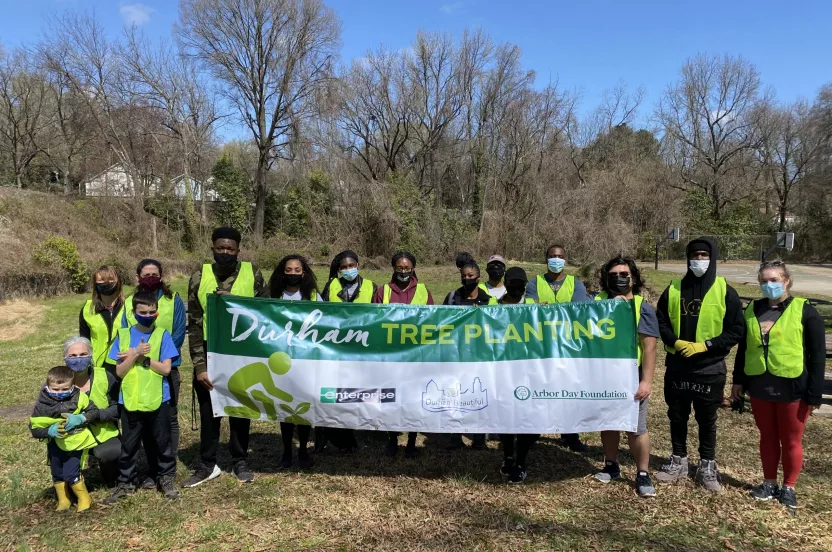Give before midnight on July 31 to double your impact where trees need us most. CHOOSE A PROJECT
Arbor Day fall shipping started this week, which means your new trees will be arriving soon and ready to plant. Thousands of trees will be shipped from the Arbor Day nursery. Here are the 10 most popular Arbor Day nursery trees finding their new homes.
- Green Giant Arborvitae Thuja standishii x plicata 'Green Giant' The green giant arborvitae is a large, vigorous, fast-growing evergreen—shooting up by as much as 3' per year until maturity. Its natural pyramidal to conical form boasts dense, rich green foliage that darkens or bronzes slightly in the winter.
This is an exceptional landscape tree for use as a screen, hedge or single specimen. It is also resistant to wind once established and can withstand heavy ice or snow, making it a good choice for a natural windbreak.
2. American Arborvitae Thuja occidentalis
This native evergreen is a hard-working, versatile specimen. The narrow, pyramid shape makes it a natural choice for windbreaks. It requires almost no care when used as a hedge or screen. Pairs of these hardy trees make great accents for doors and garden gates. And single trees soften house corners.
3. Quaking Aspen Populus tremuloides If there were a Guinness Book of World Records for trees, the quaking aspen would be in it - several times. First, it has the widest natural range of any tree in North America, spanning 47 degrees of latitude (equal to half the distance from the equator to the North Pole), 110 degrees of longitude (nine time zones) and elevations from sea level to timberline. It is also the largest living organism, growing in clones that reproduce primarily by sending up sprouts from their roots. And as far as the oldest ... a clone in Minnesota has been estimated to be 8,000 years old.
It is not a tree for all places. But planted in the right location, the quaking aspen is a delight of color, movement and sound.
4. Canadian Hemlock Tsuga Canadensis This hemlock is one of our members’ favorites for privacy screens and hedges because of its handsome, graceful appearance and ability to be sheared to any height or shape. The tree is also one of only few evergreens that can handle full sun and full shade, though it prefers a site where it can receive both shade and sun.
If you’re in need of an evergreen landscape tree for a privacy screen, grouping or foundation planting, the Canadian hemlock may be a good solution.
5. Eastern Redcedar Juniperus virginiana
The eastern redcedar tree is a common sight throughout most of the plains states and eastern United States on road cuts, in fence rows and scattered across abandoned fields—especially where limestone soils are present. It is an aromatic tree, with reddish wood giving off the scent of cedar chests and crushed fruit providing a whiff of the gin they once flavored.
Thanks to its tolerance of heat, salt, a wide range of soils and other adverse conditions, the eastern redcedar can be put to good use on the farm in windbreaks and in city landscapes for hedges, screens, clumps or even as specimen trees.
6. Sugar Maple Acer saccharum The sugar maple is one of America’s best-loved trees. In fact, more states have claimed it as their state tree than any other single species—for New York, West Virginia, Wisconsin and Vermont, the Maple Tree stands alone.
While commercially planted for its delicious syrup and value as lumber, this maple tree makes a great addition to any yard or park. And one of its most prominent features is amazing fall color. As the seasons change, the leaves turn vibrant shades of yellow, burnt orange and red.
7. Red Maple Acer rubrum
Red maple is one of the best named of all trees, featuring something red in each of the seasons—buds in winter, flowers in spring, leafstalks in summer, and brilliant foliage in autumn. This pageant of color, along with the red maple's relatively fast growth and tolerance to a wide range of soils, makes it a widely planted favorite.
The natural range of red maple begins roughly at the eastern edge of the Great Plains north to Lake Superior, extending eastward to the Atlantic. But homeowners and urban foresters are growing this tree all across the United States.
Read Red Maple: Sunset in the Forest
8. Loblolly Pine Pinus taeda The loblolly pine is an important American timber tree that is also cloaked in beauty during much of the year. With a natural range reaching across the southeastern United States, this pine is distinguished by its large, columnar trunk; attractive bark in broad, reddish-brown plates; and its pale green needles.
As one of the fastest growing southern pines, it is used for a quick screen in many landscapes.
9. Colorado Blue Spruce Picea pungens One of our most popular ornamental conifers, the Colorado blue spruce (or simply, blue spruce) is a truly magnificent sight. Perhaps Donald Culrose Peattie described it best in A Natural History of Western Trees. "This insistently pretty tree displays its charms of tier on tier of branches graduated in perfect symmetry from the longest boughs that sweep the ground to the slender but strong top."
10. Forsythia Forsythia x intermedia There’s no better way to welcome the coming of spring than with the profusion of yellow blooms covering graceful, arching branches. The forsythia is a fast-growing, hardy shrub that blooms early—providing a sunny sight before the rest of the landscape greens up.







